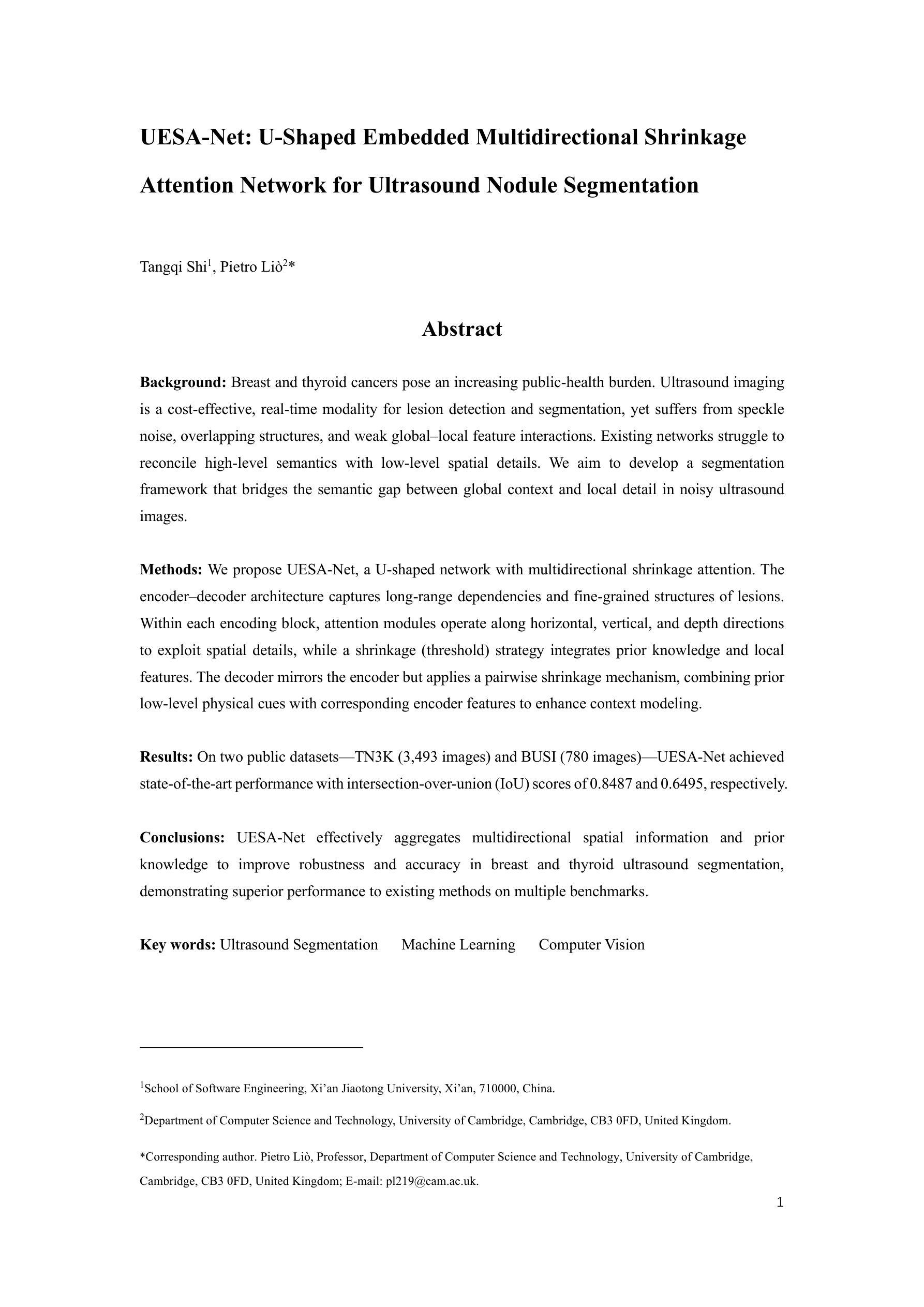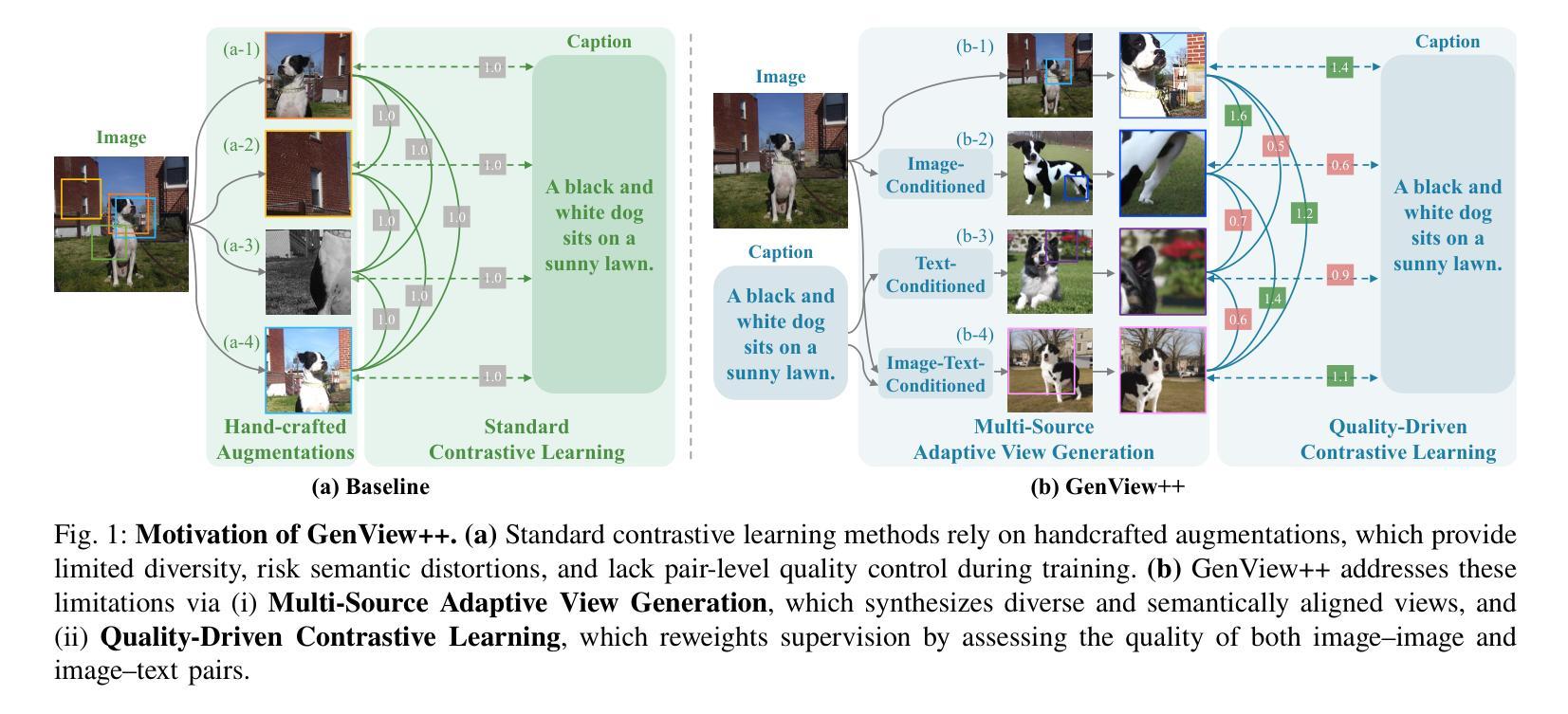⚠️ 以下所有内容总结都来自于 大语言模型的能力,如有错误,仅供参考,谨慎使用
🔴 请注意:千万不要用于严肃的学术场景,只能用于论文阅读前的初筛!
💗 如果您觉得我们的项目对您有帮助 ChatPaperFree ,还请您给我们一些鼓励!⭐️ HuggingFace免费体验
2025-10-01 更新
UESA-Net: U-Shaped Embedded Multidirectional Shrinkage Attention Network for Ultrasound Nodule Segmentation
Authors:Tangqi Shi, Pietro Lio
Background: Breast and thyroid cancers pose an increasing public-health burden. Ultrasound imaging is a cost-effective, real-time modality for lesion detection and segmentation, yet suffers from speckle noise, overlapping structures, and weak global-local feature interactions. Existing networks struggle to reconcile high-level semantics with low-level spatial details. We aim to develop a segmentation framework that bridges the semantic gap between global context and local detail in noisy ultrasound images. Methods: We propose UESA-Net, a U-shaped network with multidirectional shrinkage attention. The encoder-decoder architecture captures long-range dependencies and fine-grained structures of lesions. Within each encoding block, attention modules operate along horizontal, vertical, and depth directions to exploit spatial details, while a shrinkage (threshold) strategy integrates prior knowledge and local features. The decoder mirrors the encoder but applies a pairwise shrinkage mechanism, combining prior low-level physical cues with corresponding encoder features to enhance context modeling. Results: On two public datasets - TN3K (3493 images) and BUSI (780 images) - UESA-Net achieved state-of-the-art performance with intersection-over-union (IoU) scores of 0.8487 and 0.6495, respectively. Conclusions: UESA-Net effectively aggregates multidirectional spatial information and prior knowledge to improve robustness and accuracy in breast and thyroid ultrasound segmentation, demonstrating superior performance to existing methods on multiple benchmarks.
背景:乳腺癌和甲状腺癌给公共卫生带来了日益加重的负担。超声成像是一种经济高效的实时病变检测与分割技术,但存在斑点噪声、结构重叠以及全局与局部特征互动较弱等问题。现有网络很难在高层次语义与低层次空间细节之间进行协调。我们的目标是开发一个分割框架,以缩小全局上下文和局部细节之间的语义差距,特别是在噪声超声图像中。
方法:我们提出了UESA-Net,这是一个U型网络,具有多方向收缩注意力。编码器-解码器架构捕捉了病变的长程依赖性和精细结构。在每个编码块中,注意力模块沿水平、垂直和深度方向运行以利用空间细节,而收缩(阈值)策略则整合了先验知识和局部特征。解码器与编码器镜像对应,但采用了一种配对收缩机制,结合先前的低层次物理线索与相应的编码器特征,以增强上下文建模。
结果:在TN3K(3493张图像)和BUSI(780张图像)两个公共数据集上,UESA-Net取得了最先进的性能,交并比(IoU)得分分别为0.8487和0.6495。
论文及项目相关链接
PDF 22 pages,2 figures,4 tables
Summary
本文提出了一种名为UESA-Net的超声图像分割框架,用于乳腺癌和甲状腺癌的超声检测。该框架结合了全局上下文和局部细节信息,通过多方向收缩注意力机制增强噪声超声图像的分割性能。在TN3K和BUSI两个公共数据集上的实验结果表明,UESA-Net达到了最先进的性能。
Key Takeaways
- UESA-Net旨在缩小全局上下文和局部细节之间的语义差距,提高噪声超声图像的分割性能。
- UESA-Net采用U型网络结构,结合多方向收缩注意力机制。
- 编码器-解码器架构用于捕捉病变的长程依赖关系和精细结构。
- 每个编码块中的注意力模块沿水平、垂直和深度方向操作,以利用空间细节。
- 采用收缩策略整合先验知识和局部特征。
- 解码器采用配对收缩机制,结合低级别的物理线索和相应的编码器特征,以增强上下文建模。
点此查看论文截图

Can General-Purpose Omnimodels Compete with Specialists? A Case Study in Medical Image Segmentation
Authors:Yizhe Zhang, Qiang Chen, Tao Zhou
The emergence of powerful, general-purpose omnimodels capable of processing diverse data modalities has raised a critical question: can these jack-of-all-trades'' systems perform on par with highly specialized models in knowledge-intensive domains? This work investigates this question within the high-stakes field of medical image segmentation. We conduct a comparative study analyzing the zero-shot performance of a state-of-the-art omnimodel (Gemini, the Nano Banana’’ model) against domain-specific deep learning models on three distinct tasks: polyp (endoscopy), retinal vessel (fundus), and breast tumor segmentation (ultrasound). Our study focuses on performance at the extremes by curating subsets of the easiest'' and hardest’’ cases based on the specialist models’ accuracy. Our findings reveal a nuanced and task-dependent landscape. For polyp and breast tumor segmentation, specialist models excel on easy samples, but the omnimodel demonstrates greater robustness on hard samples where specialists fail catastrophically. Conversely, for the fine-grained task of retinal vessel segmentation, the specialist model maintains superior performance across both easy and hard cases. Intriguingly, qualitative analysis suggests omnimodels may possess higher sensitivity, identifying subtle anatomical features missed by human annotators. Our results indicate that while current omnimodels are not yet a universal replacement for specialists, their unique strengths suggest a potential complementary role with specialist models, particularly in enhancing robustness on challenging edge cases.
通用多模态omnimodels的兴起引发了一个关键问题:这些“全能”系统是否能在知识密集型领域与高度专业化的模型表现相当?本研究在医疗图像分割的高风险领域探讨了这个问题。我们进行了一项比较研究,分析了一项最先进的omnimodel(Gemini,“Nano Banana”模型)在三个不同任务(息肉内镜检查、视网膜血管和乳腺癌肿瘤分割的超声检查)上与特定领域的深度学习模型的零样本性能。我们的研究侧重于通过整理专业模型准确性的“最容易”和“最困难”案例子集来观察极端性能表现。我们的研究发现了一个微妙且依赖于任务的环境。对于息肉和乳腺癌肿瘤的分割,专业模型在简单样本上表现出色,但在困难样本上omnimodel显示出更大的稳健性,在这些样本上专业模型会发生灾难性的失败。相反,对于精细的视网膜血管分割任务,专业模型在简单和困难的情况下均表现出卓越的性能。有趣的是,定性分析表明omnimodels可能具有更高的敏感性,能够识别出人类注释器遗漏的细微解剖特征。我们的结果表明,虽然当前的omnimodels还不是专业模型的通用替代品,但它们的独特优势表明它们有可能与专业模型互补,特别是在提高对具有挑战性的边缘情况的稳健性方面。
论文及项目相关链接
PDF 15 pages, 7 figures
Summary
本摘要探讨了强大的通用型多任务模型在医疗图像分割等高专业领域内的表现。对比研究了最先进的多任务模型(Gemini,“Nano Banana”模型)与领域特定深度学习模型在三个不同任务上的零样本性能。研究发现,在极端情况下,多任务模型展现出独特的优势,如在息肉和乳腺癌肿瘤的分割上,硬样本上表现更稳健。而在视网膜血管分割等精细任务上,特定领域的模型表现更优。此外,定性分析显示多任务模型可能具有更高的敏感性,能识别出人类注释器遗漏的细微解剖特征。当前的多任务模型尚未成为专业模型的全面替代品,但在处理复杂边缘案例时,它们具有潜在的互补作用。
Key Takeaways
以下是本摘要的主要观点或关键点:
- 通用的多任务模型(Gemini,“Nano Banana”模型)在医疗图像分割领域的性能受到关注。研究表明它们在某些任务上的表现可匹配高度专业化的模型。
- 研究在息肉和乳腺癌肿瘤的分割上对比了多任务模型和领域特定模型的性能,结果显示在某些极端情况下(如困难样本),多任务模型更稳健。
- 在视网膜血管分割这类精细任务中,特定领域的深度学习模型表现出优势。
- 定性分析显示多任务模型具有更高的敏感性,能识别出细微解剖特征,甚至超越人类注释器的识别能力。
- 当前的多任务模型尚未全面取代专业领域模型,但在处理复杂或特殊情况下具有潜在的应用价值,特别是在增强稳健性方面。
- 研究结果揭示了在专业领域结合使用多任务模型和领域特定模型的潜在互补作用。
点此查看论文截图

